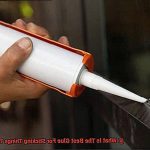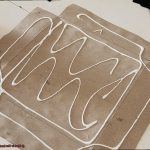Step into a kitchen transformed, where exquisite tile flooring effortlessly blends with the cozy embrace of wooden cabinetry. This captivating union isn’t just eye candy; it’s a testament to the power of choosing the right glue.
When you’re ready to install tile on wood, you need an adhesive that can withstand the test of time and hold everything together like a boss. But with so many options out there, how do you find the perfect match? Fear not, fellow DIY enthusiast. We’ve got you covered.
In this guide, we’ll unveil the secrets behind finding the best glue for tile to wood. Get ready to dive deep into the world of adhesives and discover how to create a seamless bond that will leave your floors looking flawless for years to come. So grab your tool belt and let’s get started.
Factors to Consider when Choosing Glue for Tile to Wood
Contents
- 1 Factors to Consider when Choosing Glue for Tile to Wood
- 2 Epoxy Adhesive: An Overview
- 3 Polyurethane Adhesive: An Overview
- 4 Recommended Brands of Glue for Tile to Wood
- 5 Different Types of Tiles and Woods Require Different Glues
- 6 Proper Surface Preparation is Crucial for a Strong Bond
- 7 Tips on How to Apply Glue for Tile to Wood
- 8 Common Mistakes When Applying Glue for Tile to Wood
- 9 Conclusion
In the world of tile to wood bonding, selecting the right glue is paramount to achieving a flawless and enduring installation. A multitude of factors must be taken into account to ensure a strong bond that can withstand the test of time. This article will provide you with a comprehensive guide on the crucial factors to consider when choosing glue for tile to wood applications.
Type of Tile and Wood:
The type of tile and wood being used plays a pivotal role in determining the most suitable glue. Different materials have distinct adhesive requirements. For instance, while epoxy adhesives work well with most tile types, specific natural stone tiles may necessitate specialized adhesives due to their porous nature. Furthermore, exotic woods may have unique adhesive recommendations that should be followed for optimal results.
Moisture Resistance:
Given that tile installations are frequently exposed to moisture, it is imperative to select a glue with exceptional moisture resistance. This is especially vital when bonding tiles to wood since wood tends to expand and contract with fluctuations in humidity. Opting for a moisture-resistant glue will effectively prevent any loosening or detachment of tiles over time, ensuring a steadfast bond.
Flexibility:
Flexibility is a critical factor to consider when it comes to adhesive selection for tile to wood bonding. Wood and tile can exhibit varying rates of expansion and contraction due to temperature changes or external factors. By choosing a flexible adhesive, you allow for some movement without compromising the bond between the tile and wood, ultimately guaranteeing long-lasting durability.
Adhesion Strength:
To maintain secure attachment between the tiles and wood surface, it is vital to opt for a glue with exceptional adhesion strength. Take into account the weight and foot traffic that the installation will endure, and select an adhesive capable of withstanding these conditions without causing tiles to loosen or detach over time. High adhesion strength ensures a reliable and resilient bond.
Drying Time:
Drying time is an essential consideration, particularly if you have time constraints for your project. Some glues may require lengthy drying times, which can impede the completion of your tile installation. To expedite the process without compromising the quality of the bond, consider opting for glues with quicker drying times.
Epoxy Adhesive: An Overview
When it comes to bonding tile to wood, there’s one adhesive that stands above the rest in terms of strength, durability, and versatility – epoxy adhesive. As an expert in the field, I’m here to give you a captivating overview of why epoxy adhesive should be your top choice for this task.
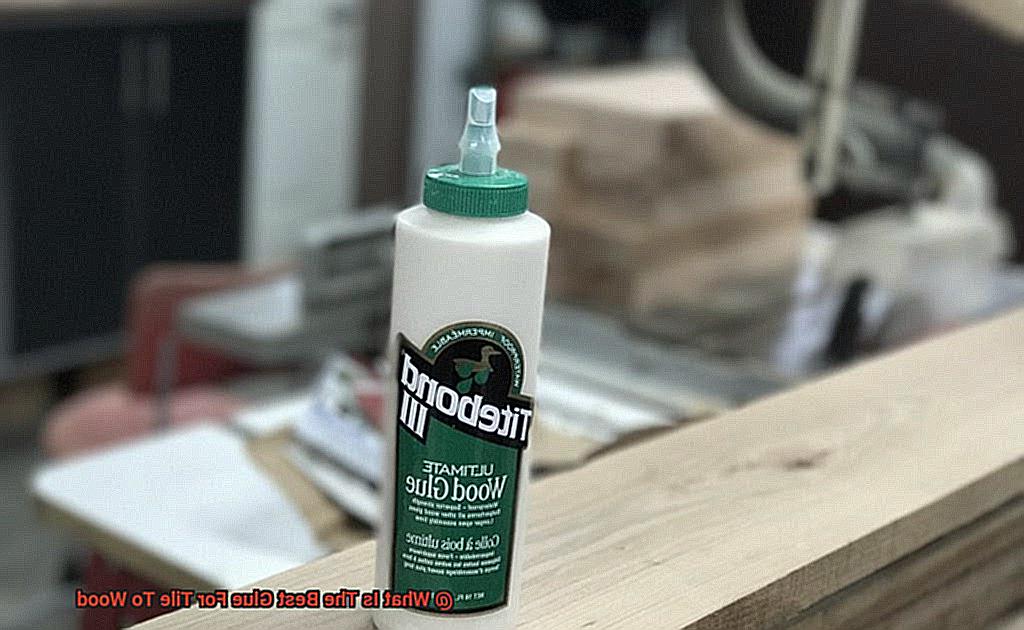
Strength and durability are the cornerstones of epoxy adhesive. This two-part system, consisting of a resin and a hardener, undergoes a chemical reaction when mixed together, creating an unbeatable bond that can withstand heavy loads and high levels of stress. No matter the weight or pressure your tile may face, epoxy adhesive has the tensile strength to resist pulling forces and keep everything securely in place. It also boasts excellent shear strength, meaning it can hold up against forces that cause surfaces to slide against each other.
But epoxy adhesive doesn’t just excel in strength; it’s also highly resistant to moisture and chemicals. This makes it perfect for areas where water exposure is common, such as bathrooms and kitchens. With epoxy adhesive, you can trust that your bond will remain intact even in the face of wet conditions. Additionally, it’s resistant to most household chemicals, ensuring that nothing will compromise the longevity of your installation.
When it comes to application, epoxy adhesive offers versatility in its forms. You can choose between liquid and paste forms depending on your specific needs. The liquid form is ideal for thin layers of adhesive, while the paste form allows for thicker applications when necessary.
Now let’s dive into the process of using epoxy adhesive for bonding tile to wood. Proper surface preparation is crucial for a successful installation. Both the tile and wood surfaces should be meticulously cleaned, ensuring they are free from any dirt, grease, or debris. Additionally, slightly roughening the surfaces can enhance adhesion by providing more surface area for the adhesive to bond to.
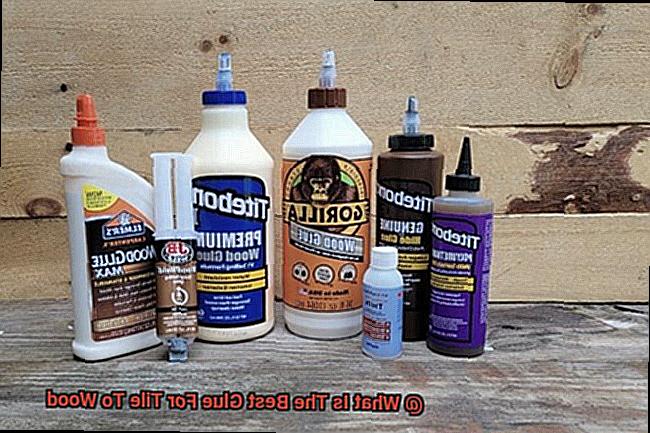
Once the surfaces are prepared, it’s time to follow the manufacturer’s instructions and mix the epoxy adhesive. Pay close attention to the recommended mixing ratios to guarantee a strong bond. After mixing, apply the adhesive evenly onto both the tile and wood surfaces using a trowel or a notched trowel. Press the tile firmly onto the wood, ensuring complete contact between the adhesive and both surfaces.
Polyurethane Adhesive: An Overview
Polyurethane adhesive: it’s the superhero glue you need for bonding tile to wood surfaces. Get ready to explore the incredible advantages of this versatile adhesive that can handle anything you throw at it.
First off, let’s talk about its unbeatable bonding capabilities. When you’re bonding tile to wood, you need an adhesive that can withstand heavy loads, temperature changes, and moisture exposure. Well, guess what? Polyurethane adhesive checks all those boxes and more. It forms a bond so strong that it can handle any challenge that comes its way, protecting your tiles like a true superhero.
But here’s where it gets even better. Unlike other glues that become brittle or break under stress, polyurethane adhesive stays flexible even after it cures. That means your bond won’t crack or break when the wood expands or contracts. It’s like having a trusty sidekick that keeps everything in place no matter what.
Now let’s talk about the wet stuff. Water and wood don’t always play nicely together, but with polyurethane adhesive, you don’t have to worry about soggy tiles. This adhesive is resistant to water and moisture, so even in high humidity or wet environments like bathrooms or kitchens, your bond will stay strong. No water damage here.
But wait, there’s more. Polyurethane adhesive has an amazing gap-filling capability. It can fill in any gaps or irregularities between the tile and wood surfaces, giving you a seamless and beautiful finish. This extra filling also provides additional support and stability to your tiles, reducing the risk of cracks or loosening over time. It’s like having a sidekick that smooths out all the imperfections.
And that’s not all. Polyurethane adhesive is not only resistant to water but also to chemicals and solvents. So whether you’re dealing with oils, cleaning agents, or other common household chemicals, your bond will stay intact. It’s like having a shield that protects your tiles from any chemical attack.
And the best part? Applying polyurethane adhesive is a breeze. It usually comes in a cartridge form and can be easily dispensed using a caulking gun. Just follow the manufacturer’s instructions on how to apply and you’ll have a bond that’s as strong as any superhero’s grip.
Recommended Brands of Glue for Tile to Wood
I’m about to unveil the esteemed and highly recommended brands of glue for tile to wood. These glues are the superheroes of the adhesive world, possessing unrivaled bonding capabilities that will ensure your tiles remain firmly adhered.
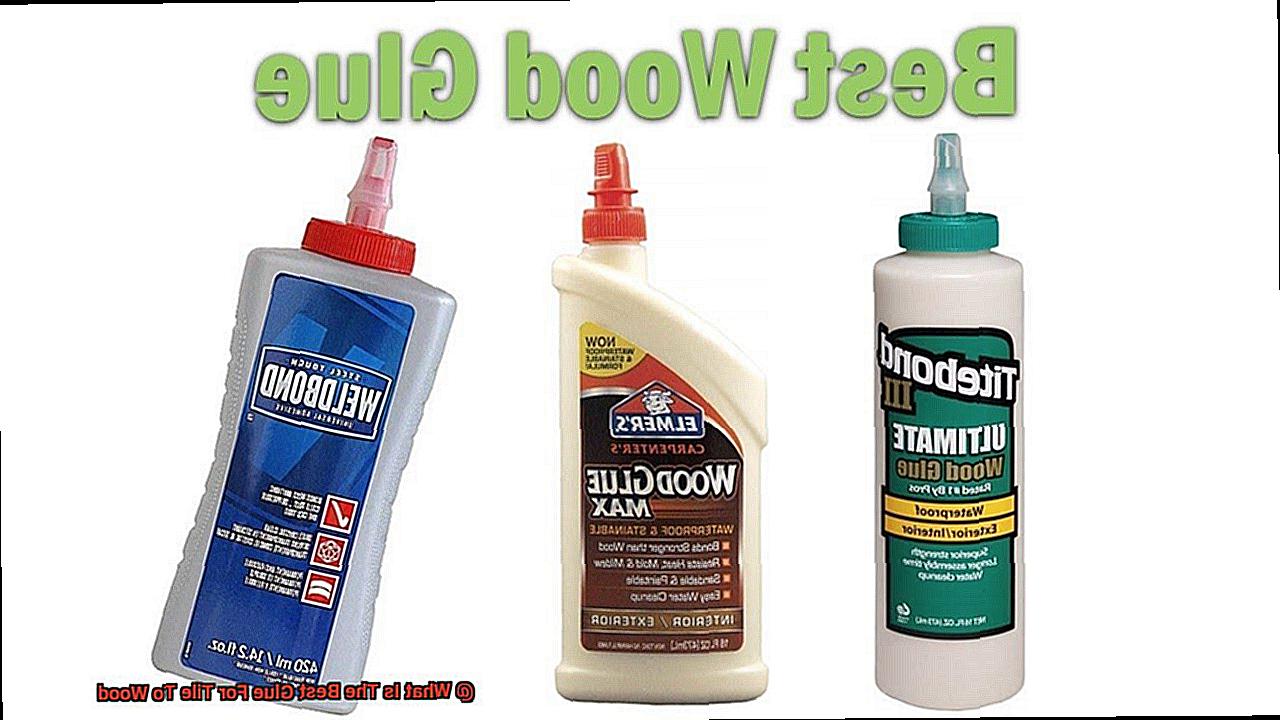
First in line is the mighty Laticrete. This brand is renowned for its exceptional tile adhesives, specially formulated to bond seamlessly with wood surfaces. With their extraordinary bond strength and unwavering performance, Laticrete products are akin to the invincible Superman of glues. Offering a diverse range of adhesives, including thin-set mortar and epoxy options, Laticrete caters to every tile and wood combination imaginable.
Next up, we have the formidable Mapei. Like Batman swooping in to save the day, Mapei offers a wide array of adhesive solutions for bonding tiles to wood substrates. These adhesives boast unparalleled bond strength and an impenetrable resistance to water and moisture, ensuring an unbreakable union between your tiles and wood surface. Not only that, but Mapei even provides specialized adhesives for different types of tiles, allowing you to customize your adhesive selection according to your precise needs.
Ardex emerges as yet another hero in the realm of tile-to-wood adhesives. Their products are meticulously designed to deliver robust adhesion between tiles and wood surfaces, guaranteeing that your tiles remain steadfast over time. With options ranging from cement-based to epoxy-based adhesives, Ardex presents an extensive array of choices that cater to individual preferences.
But hold on, because there’s more. Bostik bursts onto the scene as a savior armed with a wide range of adhesive products perfectly suited for bonding tiles to wooden substrates. These adhesives exhibit unparalleled bond strength, flexibility, and an indomitable resistance to moisture, making them the ideal choice for both interior and exterior tile installations on wood surfaces. With Bostik at your side, you can trust that your tiles will remain securely in place, come what may.
Different Types of Tiles and Woods Require Different Glues
It’s a masterpiece of craftsmanship achieved through the power of glue. But did you know that not all glues are created equal? Different types of tiles and woods require specific glues to ensure a strong and lasting bond. In this article, we’ll take a closer look at the intricate relationship between various materials and glues, unveiling the secrets behind successful tile to wood installations.
Porcelain and Ceramic Tiles:
Smooth and non-porous, porcelain and ceramic tiles demand a glue that can match their density and provide impeccable bonding properties. Enter thin-set mortar adhesive, a remarkable creation made from cement and water. This magical paste is spread on the wood surface, forming an unyielding connection between the tile and wood. It’s the perfect recipe for a flawless finish.
Natural Stone Tiles:
The allure of natural stone tiles, such as marble, granite, or slate, lies in their unique characteristics – porosity being one of them. To secure these ethereal stones to wood, an adhesive with penetrating qualities is essential. Epoxy-based glues rise to the occasion, delving deep into the stone’s surface and solidifying the bond. Their strength and resistance to moisture make them ideal for these captivating tiles.
Softwoods Need Gentle Embrace:
Softwoods like pine or cedar possess a supple nature compared to their more rigid hardwood counterparts. Hence, they require a gentler adhesive that can accommodate their flexibility without compromising stability. Polyvinyl acetate (PVA) glue or carpenter’s glue are often employed for this purpose. These versatile glues are easy to apply, drying transparently while providing robust adhesion. Additionally, they boast water-resistant properties, making them suitable for areas prone to moisture.
Hardwoods Crave Unyielding Bonds:
When it comes to hardwoods like oak or maple, a more substantial adhesive is necessary to tackle their density and ensure an unyielding connection. Enter polyurethane glue, the hero of hardwood bonding. This exceptional glue expands during curing, expertly filling any gaps or irregularities between the tile and wood. The result is a tight and unwavering embrace that will stand the test of time.
Environmental Considerations:
The environment in which tiles are installed can greatly impact the performance of glues. Factors like temperature, humidity, and moisture exposure play a significant role in determining the longevity of the bond. It is crucial to select a glue specifically formulated to withstand these environmental conditions, ensuring that your tiles remain steadfast regardless of the challenges they may face.
Proper Surface Preparation is Crucial for a Strong Bond
In the world of bonding tile to wood, there’s a secret ingredient that separates the weak bonds from the unbreakable ones: proper surface preparation. This crucial step sets the stage for a strong and long-lasting bond between these two materials. In this article, we’ll explore why surface preparation is absolutely crucial and equip you with a step-by-step guide to achieving the perfect bond. Get ready to delve into the fascinating world of surface preparation.
Step 1: Cleanliness – The Foundation of a Strong Bond:
Before even thinking about reaching for the glue, cleanliness takes center stage. Dirt, dust, or debris lurking on either the tile or wood surface can sabotage the bond, rendering even the best glue ineffective. Armed with mild detergent, warm water, and a trusty sponge or cloth, unleash your cleaning prowess. Gently scrub away any dirt or grime, rinse with clean water, and ensure both surfaces are bone dry before proceeding.
Step 2: Banish Coatings – Clearing the Path for Success:
Like an unwanted gatecrasher at a party, existing finishes or coatings on the wood surface can disrupt the harmony between the glue and surfaces. Bid farewell to varnish, paint, or sealant as they act as barriers that prevent a strong bond from forming. Wield sandpaper or a paint stripper with determination, stripping away these coatings until you reveal the raw beauty of bare wood.
Step 3: Smooth Operator – Creating an Even Playing Field:
Roughness and unevenness on the wood surface can throw a wrench in the works of your bond. To ensure a seamless connection, take charge with your sandpaper or sanding block. Smooth out any imperfections and rough patches that could compromise the strength of your bond. Remember to wipe away any lingering dust with a clean cloth, leaving behind a pristine surface ready for the magic to happen.
Step 4: Tile TLC – Unleashing the Potential:
Now it’s time to lavish some much-needed attention on your beloved tiles. If your tiles boast any existing finishes or coatings, such as glaze or sealer, it’s time to part ways. These coatings act as formidable opponents for the glue, hindering its ability to form a robust bond. Armed with a tile stripper or abrasive pad, follow the manufacturer’s instructions diligently to bid these coatings adieu.
Tips on How to Apply Glue for Tile to Wood
Applying glue for tile to wood may seem like a daunting task, but fear not. With these expert tips, you’ll be able to achieve a secure and flawless installation. As a seasoned professional in this field, I’m here to guide you through each step. Let’s dive in and create something truly remarkable.
Surface Preparation: The Foundation of Success
Before diving into the gluing process, it’s crucial to ensure that both the tile and wood surfaces are pristine. Free the surfaces from any dust, debris, or dirt that could hinder the adhesive’s effectiveness. Imagine preparing a canvas for a masterpiece – a clean surface is essential for a successful bond.
Sanding: The Secret to Enhanced Adhesion
To enhance adhesion, lightly sand the wood surface prior to applying the glue. This simple step creates a roughened surface that allows the adhesive to grip onto the wood more effectively. Think of it as providing the perfect grip for your tiles, just like a rock climber seeking traction on a challenging wall.
Choosing the Right Glue: The Glue that Holds it All Together
Selecting the right type of glue is paramount for a secure tile-to-wood bond. Opt for epoxy or polyurethane-based glues, renowned for their strength and resistance to moisture and temperature changes. To ensure optimal results, invest in a high-quality adhesive specifically designed for tile-to-wood applications. Remember, choosing the right glue is like finding the perfect partner – it sets the foundation for a long-lasting relationship.
Applying the Glue: Precision and Perfection
When it comes to applying the glue, precision is key. Utilize a notched trowel or straight-edged spatula to ensure an even layer of adhesive on the wood surface. Take care to cover the entire area where the tile will be placed, ensuring a solid foundation for your tiles. Think of this step as delicately spreading frosting on a cake – evenness ensures a delectable end result.
Avoiding Excess Glue: A Fine Balance
While it’s important to apply enough glue for a secure bond, be mindful of excess adhesive. Applying too much glue can lead to unsightly squeezing out between the tiles, compromising both aesthetics and ease of cleaning. Maintaining a fine balance is like seasoning a dish – just enough enhances the flavors, while excess ruins the experience.
Common Mistakes When Applying Glue for Tile to Wood
In the realm of gluing tile to wood, precision is paramount. A flawlessly bonded tile installation not only enhances the aesthetics but also ensures its durability. However, there are common mistakes that can sabotage this delicate process. In this article, we will delve into these missteps and equip you with expert advice on how to sidestep them. Let’s embark on this journey towards flawless tile-to-wood bonding.
The Wrong Glue:
Choosing the right glue is the cornerstone of a strong bond between tile and wood. Beware of using unsuitable glue, as it can result in weak adhesion or even catastrophic failure over time. Opt for glues specifically designed for tile installations on wood surfaces. These glues are endowed with waterproof properties and possess strong adhesives that guarantee a robust bond.
Neglecting Surface Preparation:
Preparation is the key that unlocks success, and disregarding it can lead to disastrous outcomes. Before applying the glue, meticulously prepare the wood surface. Ensure it is pristine by eliminating any dust, dirt, or remnants of previous adhesives. Embrace the power of light sanding to create a textured canvas that accentuates the bond between the glue and wood.
Precision in Glue Application:
The devil lies in the details when it comes to applying glue for tile to wood. The quantity and technique matter greatly. Vigilantly follow the manufacturer’s instructions regarding the ideal amount of glue and its application method. Insufficient glue may result in feeble adhesion, while excessive amounts can cause unsightly seepage or unevenness in the final result. Employ a trowel or notched spreader to ensure an even distribution of glue across the wood surface.
Patience in Drying Time:
In the world of gluing, haste makes waste. Rushing through the drying and curing process can lead to a feeble bond that may crumble over time or cause tiles to loosen and shift. Respect the manufacturer’s recommended drying and curing time before proceeding with grouting or applying additional weight or stress on the tiles. Remember, a robust bond blooms with patience.
qrNu0g_zC74″ >
Conclusion
When it comes to bonding tile to wood, choosing the right glue is crucial.
The best glue for this task is one that provides a strong and durable bond, ensuring that the tiles stay in place for years to come. It should also be easy to use, allowing for a hassle-free installation process.
Additionally, the glue should be resistant to moisture and temperature changes, as these factors can affect the performance of the adhesive over time.


